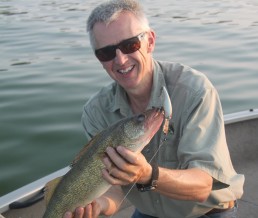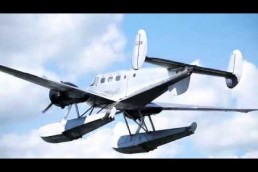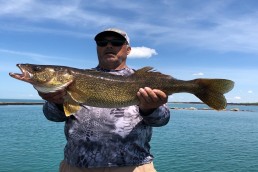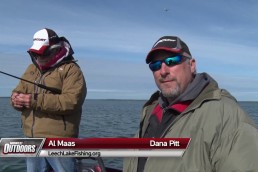The Michigan DNR and Walleye Clubs
SHARE THIS POST
Walleye fishing has never been as good as it presently is in the state of Michigan. Along with that, knowledge and information has never been easier to attain.
The DNR plants walleyes across the state. If you go to the DNR site and look up stocking, you will find a list of lakes that are planted. Many of our smaller inland lakes are planted as put-and-take resources. Other lakes are planted to help sustain ongoing walleye fisheries.
It’s hard to beat Saginaw Bay, Lake Erie, Lake St. Clair and the three major rivers on the east side of the state. However, catching a few walleyes close to home or during a family vacation are also enjoyable. If you check the stocking and creel census information, you will see what lakes were planted and when, and can find out the health and overall size of the fish in that lake. In addition, you can purchase topographic maps of the lakes from the DNR site.
I wanted to learn more about walleye fishing and to hopefully meet a few new anglers whom I could fish with. At my first meeting of the West Michigan Walleye Club, I learned more about some close-to-home fisheries than I thought possible. In addition, I discovered that one of the members taught school in my community, and both of my kids were in his class. That discussion led to a swap. He will show me his best local walleye waters if I show him my slow-trolling technique for crappies and ‘gills.
Some of these inland lakes are pretty consistent for us in landing a few keepers each time out. Landing three to five keepers in a half day is about par for the course. Applying what we learned from the newsletters of the clubs of which I am a member really helped.
Years past, we ran 3-way rigs and slowly migrated away from it. Meeting up with a few anglers in my age bracket, we rediscovered the fun of fishing a 3-way rig. We run floating Rapalas, Flatfish and Mack’s Smile Blades with a slow death hook, flies or bucktails.
A 3-way rig with a Clouser fly or a bucktail fly is a killer spring bait. In rivers and places with current, this is one deadly rig. You can fish a 3-way rig as high off of the bottom, or as tight to the bottom, as needed. You can slow-troll up a steep breakline and right back down.
Another old technique that was added back into the arsenal, thanks to a few older club members, was trolling banana baits. My favorite was the Tadpolly and that lure went goodbye. Then came the River Rocker, and that lure is fast going to the wayside. The Flatfish works wonderful under slower speeds, while the Mag Lips work great at higher speeds.
We troll Flatfish over newly emerging weedbeds. Add one or two number 7 split shot to the line, and it will skim over the new growth. We also do one of two things: We add a piece of ‘crawler to the front hook, or we remove the front hook and add a 6-inch leader with a slow death hook on the end. The lure creates a crazy, side-to-side action with the ‘crawler following behind. It works wonderfully well, yet I doubt you will find another angler doing this.
I like walleye fishing relatively close to home. Both the Holland Fish and Game Club and West Michigan Walleye Club work with the DNR on stocking rearing ponds. The fingerlings of these ponds later end up in our local lakes and rivers.
West Michigan Walleye Club has worked hand-in-hand with the DNR the past few years on a pilot program of fall fingerlings stocking. Fingerlings have a much better survival rate than fry, and fall fingerlings enjoy a huge survival rate.
Some of the fall fingerlings were ten inches long with the vast majority averaging six inches. These are big fingerlings! This can only happen when a local club with access to a pond can work jointly with the DNR.
Are you enjoying this post?
You can be among the first to get the latest info on where to go, what to use and how to use it!
WMWC raises minnows in one pond and walleye fry are dumped into another pond. Once the fry reach fingerling size, a steady diet of minnows is given. The minnow pond starts out with 10 gallons of minnows. Minnows spawn every 30 days once the water temperature reaches the 60-degree range.
To assist in the best reproduction of minnows, the pond had skids stacked up. Then two feet of PVC pipe are attached, building a little mini pyramid. Minnows will spawn on these artificial structures, and later are caught and dumped into the fingerling pond. This occurs all summer, until the ponds are drawn down and the fingerlings released.
“Often, the DNR will ask our club to assist in raising walleye fry in the rearing ponds,” said Tim Muir of the St. Clair walleye Club (lscwa.net). The Saginaw Bay Walleye Club assisted the DNR for many years until the fish population exploded on Saginaw Bay. “We work with the DNR on the rearing ponds when needed, but we also work with the DNR each year at the State Park on the free fishing weekend,” said Laura Shorky, president of the Saginaw Club.
All of these clubs work with youths, and all have tournaments. West Michigan and the St. Clair tournaments have no prize money, which I like. Being a member of the West Michigan Club, the tournaments have provided tons of information. The top five teams give a report on where and how they caught their fish. If you pay attention, you will see a pattern develop.
In addition, members can archive all past newsletters. These newsletters have tons of great information. Once again, the top five tactics for events are reported. Plus, we have a timely feature article in each issue. These articles either share a particular technique or go into detail about a body of water that we will be fishing. Folks, this is worth the cost of the $35 membership.
I plan out vacations based on the tournament results for the lakes that I wish to visit. Knowing what part of a lake to start fishing in, and what technique to use, goes a long way in a short period of time. Joining a club and working on any type of project with the DNR is fulfilling and helps us all. The DNR has a lengthy list of projects needing a pair of helping hands.
Learning from biologists as to which lakes are receiving stockings of walleyes and what the creel census has to say points you in a great direction. Joining any type of conservation or walleye club puts you into contact with others with the same interests.
I learned the “slow death” technique from a club member. I learned the best way to vertically jig fast rivers from a club member. Thru a network of anglers that I met at various club functions and at club tournaments, I have new friends across the state. We share information and assist each other.
One a side note, I love panfishing as much as walleye angling. Working with the DNR and club members, we found some of the best bluegill, perch and crappie waters to fish. During the summer, we troll crankbaits on mini planer boards, and we pound the dog-days-of-summer crappies. Once again, this was learned from an angler at a tournament.
Clubs associated with the MUCC accomplish a lot that the public can enjoy. My guess is that there is very little that cannot be accomplished if someone steps up to the plate and is willing to work toward the goal. The DNR and the MUCC would love to work with clubs, groups and individuals to enhance our outdoor activities. They can provide guidance, sometimes some funding, point you in the direction, and run some of the legal stuff
What we need across the state is individuals that are willing to step up and offer their ideas and their time. You can contact the MUCC on their web site to receive their free newsletter, to check out the various projects underway and to volunteer your help or your suggestions.
You can also join a local club or start one of your own. I would like to thank Amy Trotter, the executive director at the MUCC, for sharing just a few of the success stories and projects. I would also like to thank Tom and Larry Pachulski from the West Michigan Walleye Club on sharing just a few of their success stories and projects. There are many other great projects and great clubs within the state doing the same.
MWO
SHARE THIS POST
Did you enjoy this post?
You can be among the first to get the latest info on where to go, what to use and how to use it!
Jack Payne
Jack Payne is an accomplished angler and hunter who enjoys teaching others as much as learning from others. Seminar speaker, outdoor photography enthusiast, hunter safety instructor and volunteer at many events for both kids and adults as an instructor.



